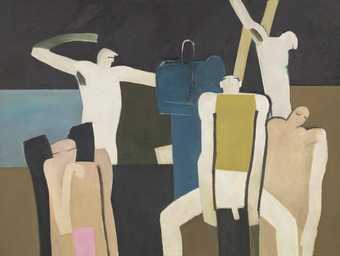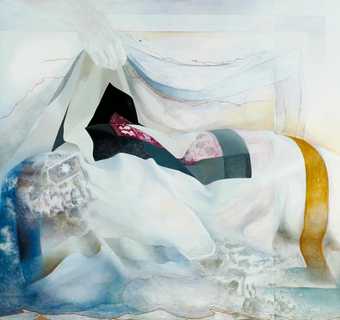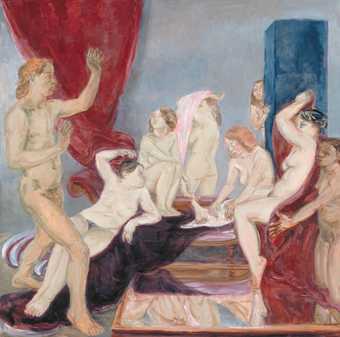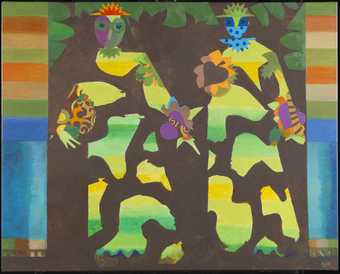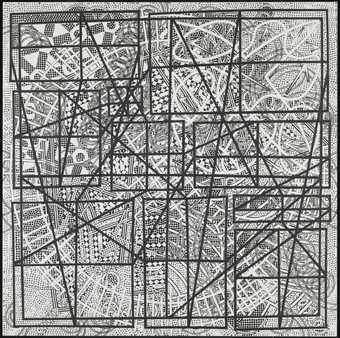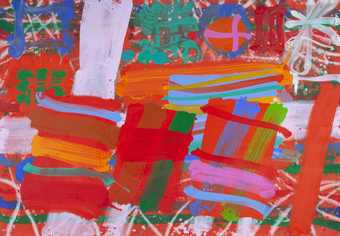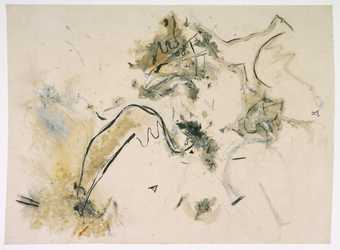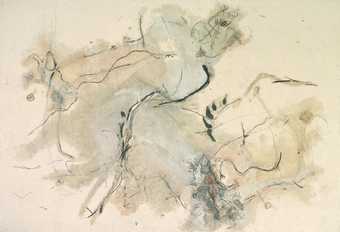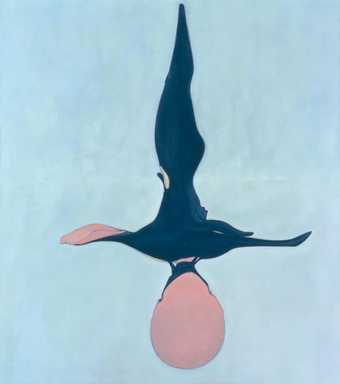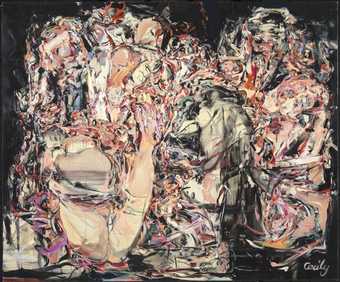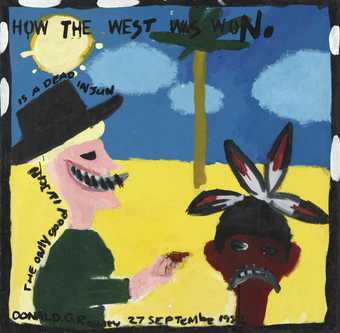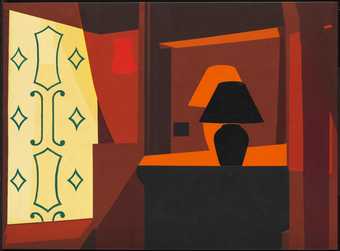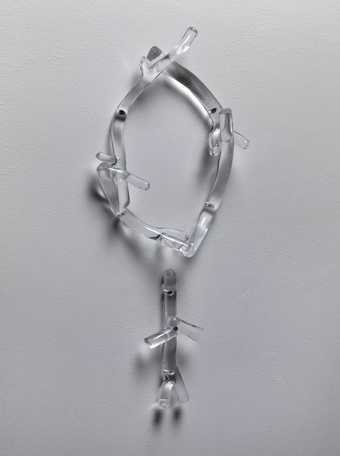
Not on display
- Artist
- Nicola Tyson born 1960
- Medium
- Acrylic paint on canvas
- Dimensions
- Support: 2032 × 1832 × 44 mm
- Collection
- Tate
- Acquisition
- Presented by the American Fund for the Tate Gallery, courtesy of Dillon Cohen 2005, accessioned 2008
- Reference
- T12599
Summary
Curtain Figure 1998 is a large painting depicting a solitary figure clothed in what appears to be a swathe of shredded blue fabric. This fabric, which dominates the centre of the composition, has a round head-like shape at its top and long, thin sections of blue that reach from this shape down to the bottom edge of the canvas. Strips of pale pink paint emerge from behind the blue area, resembling elongated limbs, a neck and a faceless head. Although the distortion of the body beneath the curtain-like apparel is such that the figure appears largely androgynous, at the top right of the composition is a cluster of horizontal bands of brown paint emanating from one of the pink areas, suggesting a woman’s head of hair. The figure is set against a flat abstracted background of beige, blue and brown paint, with sections of white gesso primer and pencil markings visible amid the expressive brushwork.
Curtain Figure was made by the British artist Nicola Tyson in her New York studio in 1998. She began by priming the linen canvas with white gesso applied in even, sweeping brushstrokes and then loosely sketching parts of the scene over this in pencil. Following this, Tyson used acrylic paint – some of which she thinned substantially – to render the figure and background in strokes of varying thickness.
First displayed at Sadie Coles Gallery in London from 4 March to 3 April 1999 in a solo exhibition entitled Nicola Tyson: New Paintings and Works on Paper, Curtain Figure was made during a shift in Tyson’s practice in 1998, which saw her move from the use of oil paint to the use of acrylic. This change in medium enabled Tyson to create looser, more expressive compositions that were closer in their handling of paint to her gestural graphite drawings than to the oil paintings that she made prior to 1998 (for comparison, see Swimmer 1995, Tate T07492). Tyson’s switch in formal approach also coincided with a more consistent focus on visceral subject matter, as is seen in Opening 1999 as well as the set of nine similarly corporeal graphite drawings Group #59 1999.
The title Curtain Figure suggests an act of bodily veiling, and the blue fabric in the painting obscures the figure’s physique, gender and other distinctive characteristics. In a review for Frieze magazine published three years before Curtain Figure was made, the art critic Dan Cameron described Tyson’s paintings as ‘not so much representations of human beings as elaborate exercises in modelling and gesture that convert the human form into a site for anatomical free-play’ (Cameron 1995, accessed 29 November 2014). Tyson has used a similar approach in Curtain Figure: the subject is reduced to a series of geometric shapes, so that human form is ambiguously suggested rather than spelled out. As the art critic Andrew Gellatly later wrote of this painting in a review of the Sadie Coles exhibition: ‘[it pares] hands down to their carpels and metacarpels’ resulting in what he calls ‘neurotic figuration’ (Gellatly 1999, p.96).
In picturing abstract, sexually ambiguous figures, Tyson’s paintings address the ways in which gender is represented visually in art and in contemporary culture more broadly. Tyson has stated that her paintings perform a ‘carnivalesque reinvention of the body’ (Tyson in Lauren Christensen, ‘Nicola Tyson on Documenting London’s Underground Punk Movement and Her Latest Photo Exhibit of “Deadly Glamorous” Cats’, Vanity Fair, 8 May 2013, http://www.vanityfair.com/online/daily/2013/05/nicola-tyson-london-punk-movement-photos, accessed 29 November 2014). This was a common preoccupation for feminist visual artists working in the 1990s and gained wider currency following the exhibition Abject Art: Repulsion and Desire in American Art at the Whitney Museum of American Art in New York in 1993, which featured work by the feminist artists Kiki Smith, Louise Bourgeois and Helen Chadwick. Drawing on the writings of the French philosopher Julia Kristeva, whose influential 1980 book Powers of Horror was translated into English in 1982, abject artists focused on the body’s functions and secretions. In Curtain Figure and Tyson’s other works from this period, such as Fingernails 1999 (which was shown alongside Curtain Figure at Sadie Coles Gallery in 1999) and Spilled Guts 1999, the artist presents the body in its distorted, raw state, as a counter to traditional notions of feminine beauty.
Further reading
Dan Cameron, ‘Nicola Tyson’, Frieze, no.23, June–August 1995, http://www.frieze.com/issue/review/nicola_tson/, accessed 29 November 2014.
Andrew Gellatly, ‘Nicola Tyson’, Frieze, no.47, June–August 1999, p.96.
Alice Butler
December 2014
Supported by Christie’s.
Does this text contain inaccurate information or language that you feel we should improve or change? We would like to hear from you.
Display caption
Trained in London during the 1980s, Nicola Tyson is now based in New York, where she staged her first solo show in 1994. Tyson describes her work as 'psycho-figuration' through which she examines issues of identity, gender and sexuality. She depicts mainly solitary female figures, typically set against minimal or flatly painted backgrounds. Often these figures begin as self-portraits that are then contorted into androgynous beings. With Curtain Figure, the title may suggest a veiling of the female body. Yet the physical presence has been radically metamorphosed beyond fixed sexual identity. Nicola Tyson's work signals the return to painting as an expressive medium among the generation of artists who emerged in the 1990s.
Gallery label, August 2004
Does this text contain inaccurate information or language that you feel we should improve or change? We would like to hear from you.
Explore
- abstraction(8,615)
-
- from recognisable sources(3,634)
-
- figure(2,270)
- formal qualities(12,454)
-
- gestural(763)
- clothing and personal items(5,879)
-
- cloak(192)
- curtain(250)
- figure(203)
- social comment(6,584)
-
- gender(1,689)
You might like
-
Keith Vaughan Ninth Assembly of Figures (Eldorado Banal)
1976 -
Rita Donagh Counterpane
1987–8 -
John Lessore Diana and Actaeon at the Byam Shaw
1987 -
Eileen Agar Figures in a Garden
1979–81 -
Myles Murphy Figure with Yellow Foreground
1974 -
Bernard Cohen Out There
1994–5 -
Albert Irvin OBE RA St Germain
1995 -
Avis Newman The Wing of the Wind of Madness
1982 -
Avis Newman Sensible Ellipse of Lost Origin
1985–6 -
Nicola Tyson Swimmer
1995 -
Cecily Brown Trouble in Paradise
1999 -
Donald Rodney How the West was Won
1982 -
Lubaina Himid CBE RA Carpet
1992 -
Patrick Caulfield Braque Curtain
2005 -
David Musgrave Transparent Stick Figure
2009

